We explain what the Jurassic Period was, how it is divided and the climate it presents. Also, what are its characteristics, flora, and fauna?
What was the Jurassic period?
On the geological timescale, the Jurassic Period is the second of the three periods into which the Mesozoic Era is divided (which began 252.2 million years ago and ended 66 million years ago). It is preceded by the Cretaceous period and followed by the Triassic.
Jurassic Period started 201 million years ago and ended 145 million years ago. Its name comes from the Jura mountain range, located between France and Switzerland, where the French geologist Alexandre Brongniart discovered the first fossils from this period and also established this geological system in the 19th century.
Dinosaurs proliferated and reigned, which is why it is perhaps the most famous of the Mesozoic periods. His name has become popular in contemporary culture thanks to books and films that explore the fictional possibility of the scientific recreation of dinosaurs (especially the Jurassic Park saga ).
Previous period
The Triassic Period is the beginning of the Mesozoic era. It spanned from 251 million years ago to approximately 201 million years ago.
It begins and ends with two mass extinction events: the Permian-Triassic and the Triassic-Jurassic.
In this period the supercontinent of Pangea was formed.
The first dinosaurs appeared on earth, generally bipedal and carnivorous, as well as the first mammals (evolving from mammalian reptiles). However, at the end of the Triassic the dinosaurs diversified and began to reign on Earth.
Jurassic Period Division
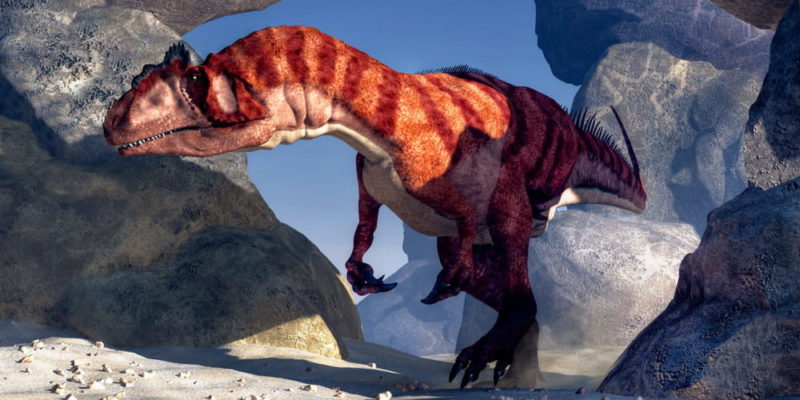
The Jurassic Period is divided into three steps called epochs or series, which comprise eleven ages or floors. These three rungs are:
- Lower or early Jurassic. It begins approximately 201.3 million years ago and ends approximately 182.7 million years ago, being the first series of the Jurassic. It is divided into the Hettangian, Sinemurian, Pliensbachian, and Toarcian ages.
- Middle Jurassic. It begins around 174.1 million years ago and ends approximately 166.5 million years ago, being the intermediate step. It is divided into the Aalenian, Bajocian, Bathonian, and Callovian floors.
- Late or Upper Jurassic. The last of the three begins about 163.5 million years ago and ends about 152.1 million years ago. It is divided into only three floors: Oxfordian, Kimmeridgian, and Titonian.
Geological features of the Jurassic
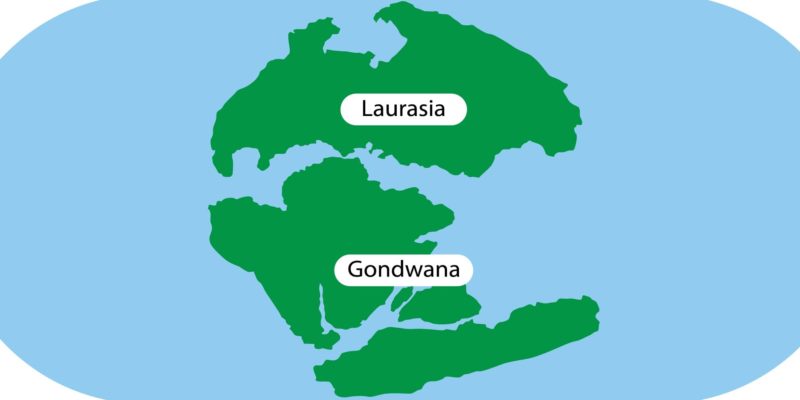
The most important geological event of the period and perhaps the entire Mesozoic era is that the fragmentation of the supercontinent of Pangea began. A slow but constant process of rifting (separation movements) occurred that divided it into two parts:
- Laurasia. It's the northern part, which later fragmented in turn into North America and Eurasia.
- Gondwana. It's the southern part, which in the middle of the Jurassic began to fragment, thus giving rise to Antarctica, Madagascar, India, Australia, Africa, and South America.
Jurassic climate
The climate at the beginning of the Jurassic was dry and warm, but the abundant movement of water caused by geological changes significantly altered it. The result was a humid subtropical climate, with abundant rainfall, which brought new life to the deserts of the interior of ancient Pangea.In the Jurassic, the temperature gradients were much more uniform than today, that is, the climate did not vary so much depending on the latitude. There is no evidence of polar ice, for example, which suggests that the ocean level was much higher than it is now.
Jurassic fauna
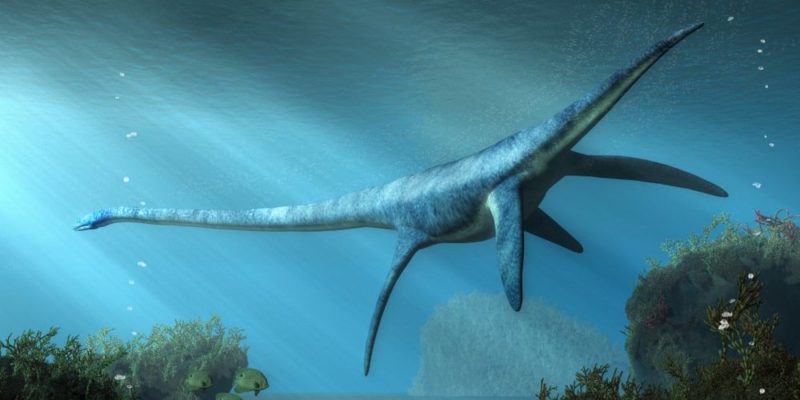 Animal life proliferated during the Jurassic, driven by geological and climatic changes that allowed a greater diversity of hunting niches and greater coexistence of species .
Animal life proliferated during the Jurassic, driven by geological and climatic changes that allowed a greater diversity of hunting niches and greater coexistence of species .Plankton floated free in the inland oceans, turning parts of the seared. Based on their presence, a whole food chain arose that, as the Jurassic passed, became larger. In this period the first frogs appear, although it was the empire of crocodiles.
The evolution of the lizards and dinosaurs of the Triassic was rapid, quickly giving rise to the largest dinosaurs, both herbivores and carnivores: Brachiosaurs, Allosaurs, Stegosaurs, Diplodocus, and others of great size and enormous weight, which in some cases required a semi-aquatic existence.
The seas were also populated by large and ferocious predators, such as ichthyosaurs, plesiosaurs, and mosasaurs, who preyed on a variety of species of cephalopods (squid-like) and ammonites. Coral reefs began their appearance in this period.
Jurassic flora
Compared to its predecessor, the Jurassic was a fairly green period. The increase in humidity levels and the warm climate allowed the expansion of vegetation throughout the new subcontinents. Deserts became more populated areas and forests, jungles, and jungles expanded.The predominant forests were coniferous, similar to the pines and araucarias of today. There were also different species of palm trees and ferns, ginkgoos, and horsetails, although there are still no inflorescences (flowers) or fruits in this period.
Appearance of birds
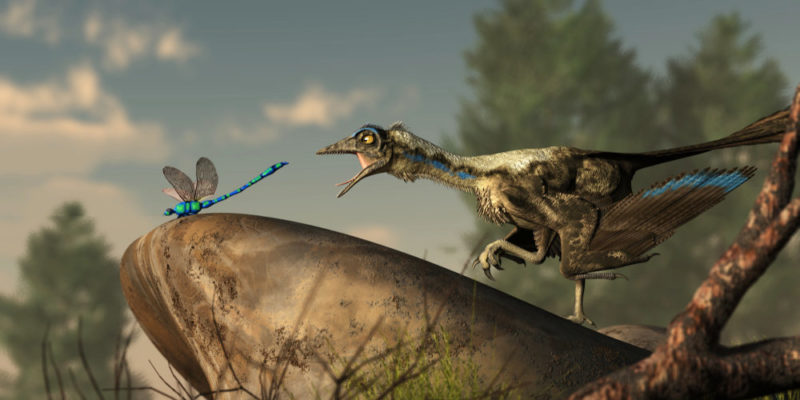 During the Jurassic, the skies were dominated by featherless pterodactyls. In addition, the primitive insects that in those times were much larger than the modern ones, due to the overabundance of oxygen in the atmosphere.
During the Jurassic, the skies were dominated by featherless pterodactyls. In addition, the primitive insects that in those times were much larger than the modern ones, due to the overabundance of oxygen in the atmosphere.However, at the end of the Jurassic, the first bird in history appears Archeopteryx, whose well-preserved fossils made it possible to prove the origin of birds from dinosaurs. In these, it can be seen with its plumage, although still with many clearly reptilian features.
The first mammals
Mammals also participated in the Jurassic, but they were a minority way of life. They were mostly small herbivores or insectivores that did not compete with the large reptiles at all.The oldest mammal discovered in the fossil record, a clear predecessor to what would become placental mammals, was found in 2011 in China and its existence was verified during the Jurassic. Thus it was shown that mammals evolved much earlier than traditionally thought.
The Jurassic Period in culture
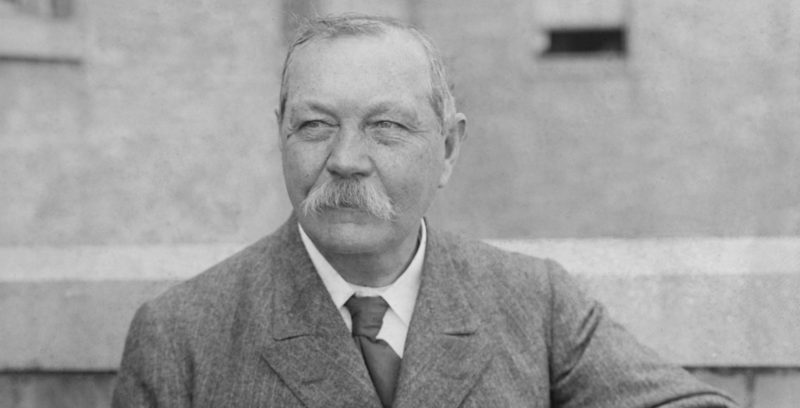 The human fascination for dinosaurs has led us to recreate in film and literary fiction an encounter between them and our species that, historically, would have been completely impossible. Some of these fictions that refer to the Jurassic or the Jurassic animals are:
The human fascination for dinosaurs has led us to recreate in film and literary fiction an encounter between them and our species that, historically, would have been completely impossible. Some of these fictions that refer to the Jurassic or the Jurassic animals are:
- The novel's fictional Scottish writer Arthur Conan Doyle The Lost World, published in 1912, and is set in the Venezuelan Amazon, where they have survived prehistoric species.
- The science fiction novel Jurassic Park by American Michael Crichton, published in 1990; as well as its 1995 sequel, The Lost World, which deals with the installation of a theme park on an island in Costa Rica, in which dinosaurs cloned from DNA found in a mosquito preserved in amber are exhibited.
- The series of films inspired by Crichton's novels: Jurassic Park (1993), directed by Steven Spielberg; The Lost World: Jurassic Park (1997), Jurassic Park III (2001), Jurassic World (2015), and Jurassic World: Fallen Kingdom (2018).
Later period: the Cretaceous
The post-Jurassic period is the Cretaceous, which begins 145 million years ago and ends approximately 66.4 million years ago. It is a particularly long period, the culmination of which is also that of the Mesozoic era.Its end is determined by the so-called K / Pg Event, which is suspected to have consisted of the fall of a meteorite in the Yucatan Peninsula, causing the extinction of the dinosaurs, among many other species.
The above content published at Collaborative Research Group is for informational and educational purposes only and has been developed by referring to reliable sources and recommendations from technology experts. We do not have any contact with official entities nor do we intend to replace the information that they emit.
Abubakr Conner brings a diverse skill set to our team, and covers everything from analysis to the culture of food and drink. He Believes: "Education is the most powerful weapon that exists to change the world." .
Leave a reply
Your email address will not be published. Required fields are marked *Recent post

Sport: What Is It, Types, Risks, Features, Characteristics and Examples

Dogs: Emergence, Features, Characteristics, Feeding and Breeds

Story: Definition, Elements, Structure, Features and Characteristics

